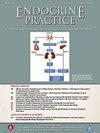Apolipoprotein Profile in Early Pregnancy and the Link to Gestational Diabetes Mellitus: Insights From Odense Child Cohort
IF 4.6
3区 医学
Q2 ENDOCRINOLOGY & METABOLISM
引用次数: 0
Abstract
Objectives
We aimed to investigate the potential associations between serum apolipoprotein levels in early pregnancy and the risk of gestational diabetes mellitus (GDM) and adverse pregnancy outcomes.
Methods
This was an observational study of the population-based Odense Child Cohort. Pregnant women were followed from inclusion until childbirth. Apolipoprotein levels, including 12 apolipoproteins (ApoA-I, ApoA-II, ApoA-IV, ApoB, ApoC-I, ApoC-II, ApoC-III, ApoD, ApoE, ApoH, ApoJ, and ApoM) were measured by targeted proteomics using liquid chromatography mass spectrometry on late first trimester serum samples stored in a biobank. GDM was defined by WHO 2013 diagnostic criteria.
Results
A total of 991 pregnant women were included, of which 415 (41.9%) were diagnosed with GDM. GDM was associated with increasing ApoB (adjusted odds ratio [OR]: 1.26, P = .002) and ApoD levels (adjusted OR: 0.84, P = .021). ApoB levels in early pregnancy correlated significantly and positively with insulin resistance (r = 0.22, P < .001) and beta-cell function in third trimester (r = 0.20, P < .001), whereas early pregnancy ApoD levels were inversely correlated with insulin resistance (r = −0.14, P < .001) and beta-cell function (r = −0.12, P < .001). Finally, high levels of ApoD was significantly associated with lower risk of large-for-gestational-age infants (adjusted OR: 0.78, P = .041).
Conclusions
High levels of ApoB and low levels of ApoD in early pregnancy were independently associated with an increased risk of GDM, insulin resistance, and large-for-gestational-age infants (low ApoD only), suggesting potential roles for future management of pregnancy outcomes.

载脂蛋白谱在妊娠早期和与妊娠糖尿病的联系:从欧登塞儿童队列的见解。
目的:我们旨在调查妊娠早期血清载脂蛋白水平与妊娠糖尿病(GDM)风险和不良妊娠结局之间的潜在关联。方法:这是一项基于人群的欧登塞儿童队列观察性研究。孕妇从纳入研究一直跟踪到分娩。采用液相色谱-质谱法,采用靶向蛋白质组学技术,对生物库中保存的孕晚期血清样品检测载脂蛋白水平,包括12种载脂蛋白(ApoA-I、ApoA-II、ApoA-IV、ApoB、ApoC-I、ApoC-II、ApoC-III、ApoD、ApoE、ApoH、ApoJ和ApoM)。GDM由WHO 2013年诊断标准定义。结果:共纳入991例孕妇,其中415例(41.9%)诊断为GDM。GDM与ApoB(调整OR: 1.26, P = 0.002)和ApoD水平升高相关(调整OR: 0.84, P = 0.021)。妊娠早期ApoB水平与胰岛素抵抗(r = 0.22, P < 0.001)和妊娠晚期β细胞功能(r = 0.20, P < 0.001)呈显著正相关,而妊娠早期ApoD水平与胰岛素抵抗(r = -0.14, P < 0.001)和β细胞功能(r = -0.12, P < 0.001)呈负相关。最后,ApoD水平高与大胎龄儿(LGA)的低风险显著相关(校正OR: 0.78, P = 0.041)。结论:妊娠早期高水平的ApoB和低水平的ApoD与GDM、胰岛素抵抗和LGA婴儿的风险增加独立相关(仅低ApoD),提示未来妊娠结局管理的潜在作用。
本文章由计算机程序翻译,如有差异,请以英文原文为准。
求助全文
约1分钟内获得全文
求助全文
来源期刊

Endocrine Practice
ENDOCRINOLOGY & METABOLISM-
CiteScore
7.60
自引率
2.40%
发文量
546
审稿时长
41 days
期刊介绍:
Endocrine Practice (ISSN: 1530-891X), a peer-reviewed journal published twelve times a year, is the official journal of the American Association of Clinical Endocrinologists (AACE). The primary mission of Endocrine Practice is to enhance the health care of patients with endocrine diseases through continuing education of practicing endocrinologists.
 求助内容:
求助内容: 应助结果提醒方式:
应助结果提醒方式:


